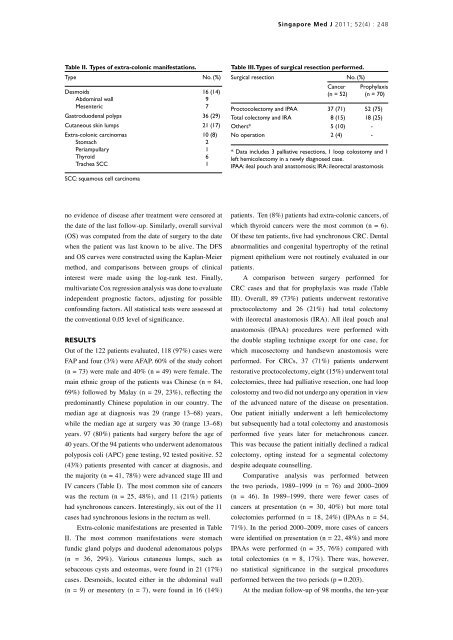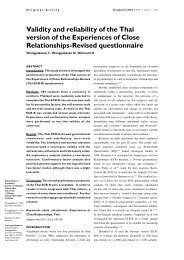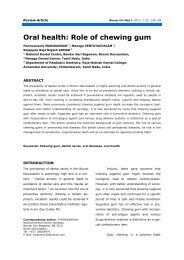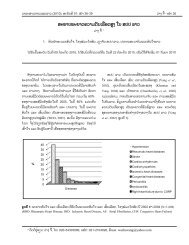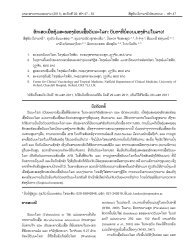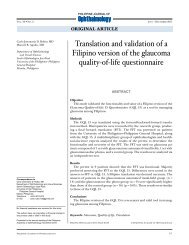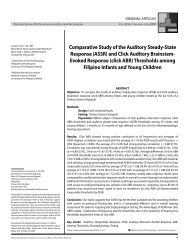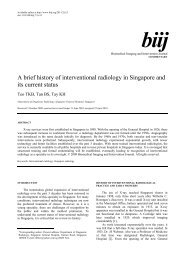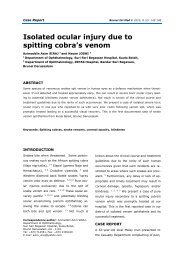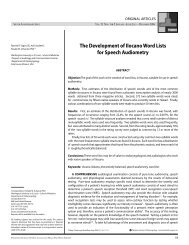PDF ( B) - APAMED Central
PDF ( B) - APAMED Central
PDF ( B) - APAMED Central
You also want an ePaper? Increase the reach of your titles
YUMPU automatically turns print PDFs into web optimized ePapers that Google loves.
Singapore Med J 2011; 52(4) : 248<br />
Table II. Types of extra-colonic manifestations.<br />
Type No. (%)<br />
Desmoids 16 (14)<br />
Abdominal wall 9<br />
Mesenteric 7<br />
Gastroduodenal polyps 36 (29)<br />
Cutaneous skin lumps 21 (17)<br />
Extra-colonic carcinomas 10 (8)<br />
Stomach 2<br />
Periampullary 1<br />
Thyroid 6<br />
Trachea SCC 1<br />
Table III. Types of surgical resection performed.<br />
Surgical resection No. (%)<br />
Cancer Prophylaxis<br />
(n = 52) (n = 70)<br />
Proctocolectomy and IPAA 37 (71) 52 (75)<br />
Total colectomy and IRA 8 (15) 18 (25)<br />
Others* 5 (10) -<br />
No operation 2 (4) -<br />
* Data includes 3 palliative resections, 1 loop colostomy and 1<br />
left hemicolectomy in a newly diagnosed case.<br />
IPAA: ileal pouch anal anastomosis; IRA: ileorectal anastomosis<br />
SCC: squamous cell carcinoma<br />
no evidence of disease after treatment were censored at<br />
the date of the last follow-up. Similarly, overall survival<br />
(OS) was computed from the date of surgery to the date<br />
when the patient was last known to be alive. The DFS<br />
and OS curves were constructed using the Kaplan-Meier<br />
method, and comparisons between groups of clinical<br />
interest were made using the log-rank test. Finally,<br />
multivariate Cox regression analysis was done to evaluate<br />
independent prognostic factors, adjusting for possible<br />
confounding factors. All statistical tests were assessed at<br />
the conventional 0.05 level of significance.<br />
Results<br />
Out of the 122 patients evaluated, 118 (97%) cases were<br />
FAP and four (3%) were AFAP. 60% of the study cohort<br />
(n = 73) were male and 40% (n = 49) were female. The<br />
main ethnic group of the patients was Chinese (n = 84,<br />
69%) followed by Malay (n = 29, 23%), reflecting the<br />
predominantly Chinese population in our country. The<br />
median age at diagnosis was 29 (range 13–68) years,<br />
while the median age at surgery was 30 (range 13–68)<br />
years. 97 (80%) patients had surgery before the age of<br />
40 years. Of the 94 patients who underwent adenomatous<br />
polyposis coli (APC) gene testing, 92 tested positive. 52<br />
(43%) patients presented with cancer at diagnosis, and<br />
the majority (n = 41, 78%) were advanced stage III and<br />
IV cancers (Table I). The most common site of cancers<br />
was the rectum (n = 25, 48%), and 11 (21%) patients<br />
had synchronous cancers. Interestingly, six out of the 11<br />
cases had synchronous lesions in the rectum as well.<br />
Extra-colonic manifestations are presented in Table<br />
II. The most common manifestations were stomach<br />
fundic gland polyps and duodenal adenomatous polyps<br />
(n = 36, 29%). Various cutaneous lumps, such as<br />
sebaceous cysts and osteomas, were found in 21 (17%)<br />
cases. Desmoids, located either in the abdominal wall<br />
(n = 9) or mesentery (n = 7), were found in 16 (14%)<br />
patients. Ten (8%) patients had extra-colonic cancers, of<br />
which thyroid cancers were the most common (n = 6).<br />
Of these ten patients, five had synchronous CRC. Dental<br />
abnormalities and congenital hypertrophy of the retinal<br />
pigment epithelium were not routinely evaluated in our<br />
patients.<br />
A comparison between surgery performed for<br />
CRC cases and that for prophylaxis was made (Table<br />
III). Overall, 89 (73%) patients underwent restorative<br />
proctocolectomy and 26 (21%) had total colectomy<br />
with ileorectal anastomosis (IRA). All ileal pouch anal<br />
anastomosis (IPAA) procedures were performed with<br />
the double stapling technique except for one case, for<br />
which mucosectomy and handsewn anastomosis were<br />
performed. For CRCs, 37 (71%) patients underwent<br />
restorative proctocolectomy, eight (15%) underwent total<br />
colectomies, three had palliative resection, one had loop<br />
colostomy and two did not undergo any operation in view<br />
of the advanced nature of the disease on presentation.<br />
One patient initially underwent a left hemicolectomy<br />
but subsequently had a total colectomy and anastomosis<br />
performed five years later for metachronous cancer.<br />
This was because the patient initially declined a radical<br />
colectomy, opting instead for a segmental colectomy<br />
despite adequate counselling.<br />
Comparative analysis was performed between<br />
the two periods, 1989–1999 (n = 76) and 2000–2009<br />
(n = 46). In 1989–1999, there were fewer cases of<br />
cancers at presentation (n = 30, 40%) but more total<br />
colectomies performed (n = 18, 24%) (IPAAs n = 54,<br />
71%). In the period 2000–2009, more cases of cancers<br />
were identified on presentation (n = 22, 48%) and more<br />
IPAAs were performed (n = 35, 76%) compared with<br />
total colectomies (n = 8, 17%). There was, however,<br />
no statistical significance in the surgical procedures<br />
performed between the two periods (p = 0.203).<br />
At the median follow-up of 98 months, the ten-year


